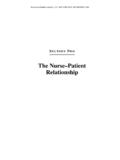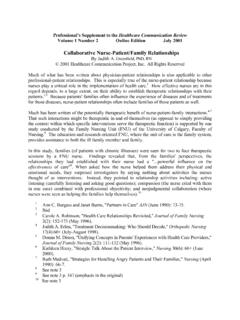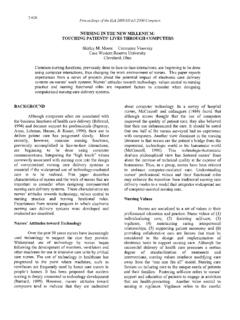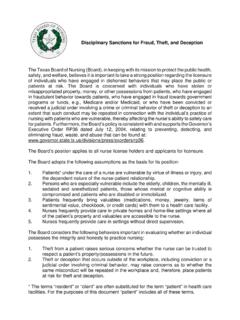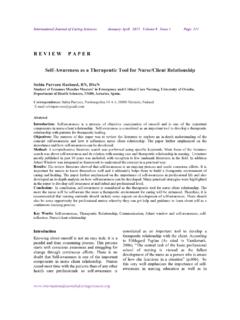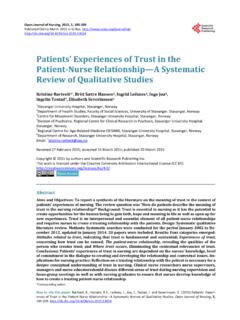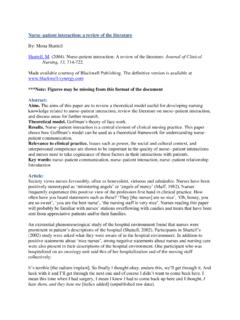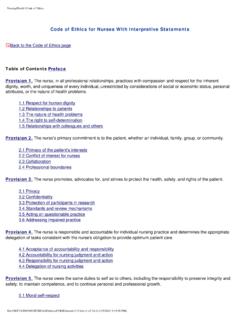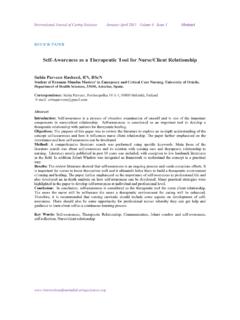Transcription of Nurse–patient relationships in palliative care
1 ISSUES AND INNOVATIONS IN NURSING PRACTICEN urse patient relationships in palliative careEsther MokBA MA PhD RN RMAssociate Professor, School of Nursing, The Hong Kong Polytechnic University, Hung Hom, Kowloon, Hong Kong, ChinaPui Chi ChiuBSc MSc RNPalliative nurse , Haven of Hope Hospital, Hong Kong, ChinaSubmitted for publication 17 February 2003 Accepted for publication 26 February 2004 Correspondence:Esther Mok,School of Nursing,The Hong Kong Polytechnic University,Hung Hom,Kowloon,Hong Kong, : E. & CHIU (2004)MOK E. & CHIU (2004)Journal of Advanced Nursing48(5), 475 483 nurse patient relationships in palliative aim of this paper is to report a study exploring aspects of nurse patientrelationships in the context of palliative there are numerous studies addressing nurse patientrelationships, little research has focused on these in the context of palliative , no previous study has examined the relationship in the Chinese data were collected from 10 hospice nurses and 10 terminally illpatients by means of open ended unstructured interviews.
2 Respondents were asked toreflect on practices and incidents that would allow an understanding of the meaning ofnurse patient relationships in palliative major categories emerged from the perspectives of patients and nurses:(1) forming a relationship of trust; (2) being part of the family; (3) refilling with fuelalong the journey of living and dying; and (4) enriched experiences. Responsesrevealed that a relationship of trust is formed, and that nurses are not only regarded ashealth professionals, but also become part of the family or a good friend. Nurses whodevelop trusting relationships demonstrate a holistic approach to caring, show theirunderstanding of patients suffering, are aware of their unvoiced needs, providecomfort without actually being asked, and are reliable, proficient, competent anddedicated in their , the achievement of the goals of patients and nurses, caring andreciprocity are important elements of nurse patient relationships in palliative relationships not only improve patients physical and emotional state, but alsofacilitate their adjustment to their illness.
3 Ease pain and can ultimately lead to a gooddeath experience. It is nurses personal qualities and skills, which are embeddedin these relationships , that constitute excellence in nursing care . Nurses also derivesatisfaction and are enriched through the : nurse patient relationship , palliative care , nurses qualities, trustIntroductionThe nurse patient relationship is viewed as central orfoundational to the practice of nursing (Benner & Wrubel1989, Ramos 1992, Tanneret , Weissman &Appleton 1995, Taylor 1998). Theoretical work on thenurse patient relationship by Peplau (1952) was critical tothe development of the notion that nursing practice encom-passed more than physical care .
4 She described four phases ofthe nurse patient relationship : orientation, identification,exploitation and resolution, and developing nursing know-ledge apart from the disease model . This conceptualization 2004 Blackwell Publishing Ltd475was subsequently expanded in the works of interactionalnurse theorists such as King (1981) and Paterson and Zderad(1976). Recent writers continue to cite the importance ofrelationship development to balance the emphasis on techni-cal skills (McQueen 2000, Chantet ). They haveemphasized that a capacity for forming relationships withothers is a key attribute of (1997) has argued that the emphasis and relianceon mechanistic models of relating often results in failure bynurses to realize the importance of relational has described five relational capacities: initiative,authenticity and responsibility; mutuality and synchrony;honouring complexity and ambiguity; intentionality in rela-ting; and re-imagining.
5 Relational capacity embraces thecaring values of nursing and the primacy of relationships incaring nursing practice. Hagerty and Patusky (2003) haveprovided an alternative framework for nurse patient inter-actions based on the theory of human-relatedness, whichconsists of four states: relatedness-connection, disconnection,enmeshment and parallelism. The four states are based onlevels of involvement and studies have explored the nature and types of nurse patient relationships (May 1991, Morse 1991, Ramos 1992,Morseet ). Morse (1991) has commented that therelationship between nurse and patient is the result of interplayor covert negotiations until a mutually satisfying relationshipis reached.
6 She has also identified four types of mutualrelationship according to the duration of contact betweennurse and patient, the needs of the patient, the commitment ofthe nurse and the patient s willingness to trust the nurse . Theyare: clinical relationship , therapeutic relationship , connectedrelationship and over-involved relationship . It is argued thatthe intensity of the negotiations depends upon the patient sperception of the seriousness of the situation and the patient sfeeling of vulnerability and care aims to promote the physical and psycho-social well-being of patients whose disease is no longerresponding to curative treatment.
7 In nurse patient relation-ships, nursing work is directed at maintenance of the bodyrather than its restoration. Emotional and psychosocialdistress are common as individuals confront the terminalphase of an illness and their impending death. One of the coreelements of good palliative care is good nurse patientrelationships. The change of focus has the effect of reconfig-uring interactions between nurse and the process of dying, time is limited and the patientis vulnerable, making the patient nurse relationship inpalliative settings an interesting area for exploration.
8 May(1995) highlighted the important role of nurses in helpingterminally ill patients to come to terms with the imminence ofdeath. Such work is highly demanding and often nurse patient relationship goes beyond sitting andlistening and talking , in which the patient is the object ofclinical attention or a subject manifesting psychosocialproblems. Here, the patient not only wishes to speak, but isalso known to the nurse in an intimate and private of the underlying structural inequality of relationsbetween nurse and patient, May has described the relation-ship as in some way pastoral.
9 The nurse expresses sympa-thetic concern, while at the same time the patient reveals themost private aspects of their life; the relationship is notreciprocal. However, some patients prefer to detach them-selves from the situation. In such cases, they do not allownurses to become involved, which makes care more difficultas nurses are then unable to perceive how patients are addition, when nurses take time to talk to patients andmeet their needs, they must then contend with other,competing, work demands. In order to take time to talk,nurses may have to re-arrange other work or re-allocate has described how the nurse patient relationship isimbued with a moral value, which is an investment thatundercuts its status as paid (1996) has emphasized that in palliative care ,primary interventions are interpersonal and that patients subjective status is given ever greater priority.
10 Spross hasdescribed the nurse patient relationship as one-sided inti-macy . The nurse would always know more about the patientthan the patient would know about the nurse . She acknow-ledges that the depth or intensity of this nurse patientrelationship makes it like friendship. However, unlikefriendship, the relationship demands conscious use andinterpretation of complex cognitive, affective, and beha-vioural knowledge to enable nurses to communicate deliber-ately to achieve therapeutic goals. Spross further describedthe central interpersonal process of nurse patient relation-ships as coaching.
